Monday, March 31, 2008
First person paternal
Thursday, March 27, 2008
Revisiting the (underground) Ozarks
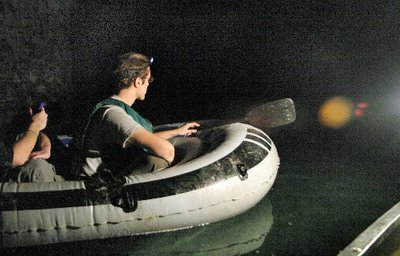 A couple of years ago, I spent an adventurous night with a group of college students who were fond of exploring forbidden places. The experience has stayed with me. Here's a bit of the story that appeared in The Joplin Globe.
A couple of years ago, I spent an adventurous night with a group of college students who were fond of exploring forbidden places. The experience has stayed with me. Here's a bit of the story that appeared in The Joplin Globe.CARTHAGE, Mo. -- Midnight. Lost in a labyrinth of rock and water.
"This happens every time," says White Rabbit casually as he dips his paddle into the water and propels the canoe a little further into the unknown. In the bow is Anne, a blond 17-year-old holding aloft a blazing Coleman lantern.
The brilliant light forces aside the darkness as if parting a curtain.
Everything looks the same: clear water tinged with a hint of green, massive pillars of gray rock, brown bats dotting the ceiling. A few bats flit overhead, disturbed by the passage of the 10 adventurers crammed into the canoe and two inflatable rafts.
The air is cool and the water colder, and the subterranean silence clings to the group as tightly as damp clothing. Even though this is their third illegal foray into the abandoned caverns at the edge of town, the group has been paddling around in a circle for nearly an hour, looking for anything familiar that might lead to the way out.
Sertile won't admit to being lost. Later, he will say, it was just a case of "spatial disorientation." Besides, they were only lost for about an hour.
In the past year, the group has ventured into areas that, for a variety of good reasons, are off limits to the public: Abandoned mines and mills across Missouri and Arkansas, the century-old Eighth Street tunnel in Kansas City, and a deactivated Nike missile battery near Pleasant Hill where the group managed to open the missile bay doors.
This sounds improbable, but they've posted video to prove it. It was a little strange, White Rabbit noted, to ride on an elevator designed for nuclear weapons.
The group's Web site, Underground Ozarks, is a combination bulletin board, travel diary, and photo album for urban exploration. The subculture is heavy with codes and aliases, and all nine members of the group identify themselves only by their online handles.
On this Saturday in the middle of October, the group has come to Carthage to gather more material and to probe around the edges of the massive underground storage facility owned by AmeriCold Logistics.
White Rabbit, an affable Missouri State University student from Springfield, doesn't care for the term "urban exploration." It's a $10 word for what nearly everybody has done, he says, at least at some point in their lives. It's about the satisfaction of going places where you don't belong and being able to brag about it later.
Tuesday, March 25, 2008
Found quote
Tuesday, March 18, 2008
James film among Spur winners
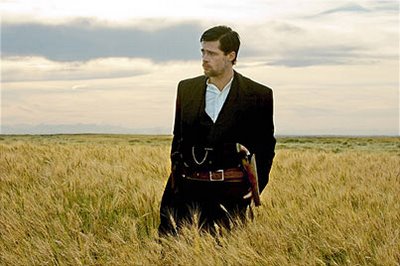
Other 2008 Spur winners include The God of Animals by Aryn Kyle (Scribner) and Tallgrass by Sandra Dallas (St. Martin's). The complete list can be found here.
Thursday, March 6, 2008
A Spur by any other name...
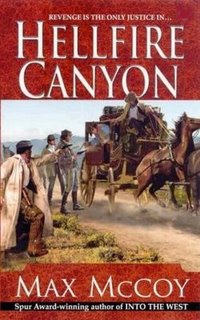 I was notified today that I've
I was notified today that I'veThe award is for a novel
Here's what the reviewer at Gravetapping Blog said last year:
"Hellfire Canyon is not the
play, but there is more—a
legend, and even folklore.
thief, but he—the story is
For some background
"The Spur Awards, given
Since then the awards have
Winners of the Spur Awards in
Wednesday, March 5, 2008
"...two words: governments lie."
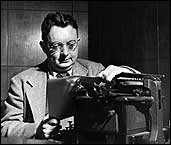 The Nieman Foundation at Harvard has created the I.F. Stone Award to honor journalistic independence.
The Nieman Foundation at Harvard has created the I.F. Stone Award to honor journalistic independence."The I.F. Stone Medal will be presented annuall to a journalist whose work captures the spirit of independence, integrity, courage and indefatigability that characterized I.F. Stone's Weekly, published 1953 - 1971," the foundation said this today in a press release. "Each year, the winner of the award will deliver a speech about his or how own experience with journalistic independence, to be followed by a workshop on the same topic."
So, who was I.F. Stone?
Well, the initials stand for Isidor Feinstein, his birth name. He added the Stone later. He was a muckraker who self-published his weekly newsletter and he died in 1989, at the age of 81. He was a left-leaning investigative reporter who taught himself Greek after retirement and wrote a book on the trial of Socrates. It's ironic that Harvard is honoring him, because for much of his life he was marginalized by the mainstream.
My favorite I.F. Stone quote?
"I am going to tell you a number of things, but if you really want to be a good journalist you only have to remember two words: governments lie."
Monday, March 3, 2008
Active Denial System? $13 million. Giving pesky peace protestors the hot foot? Priceless.
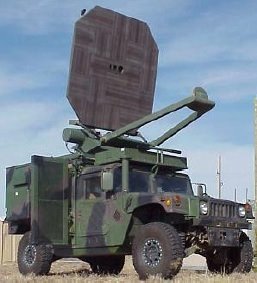 I couldn't believe what I was seeing Sunday night. Was it 60 Minutes or an advertisement paid for by the Pentagon?
I couldn't believe what I was seeing Sunday night. Was it 60 Minutes or an advertisement paid for by the Pentagon?I've loved watching the venerable news program since I was a kid, and that's a long time. On Feb. 24, for example, the show did its usual bang-up job on a trio of stories: the politically-motivated bribery conviction of former Albama governor Don Siegelman, the killing of a black reporter who dared tell the truth about a corrupt local business, and the dire implications for all of us due to the disappearance of honey bees due to colony collapse disorder. Even when I don't agree with their approach, I love Morley Safer and Dan Rather and loved (the late) Ed Bradley. Hell, I even liked Diane Sawyer.
But this new guy, David Martin -- who has been the CBS Pentagon and national security correspondent since 1993 and has filed stories for 60 Minutes Wednesday, something I've never watched -- gave a breathless report on the Active Denial System, a non-lethal crowd control device that uses millimeter waves to create a burning sensation . Martin called it "The Ray Gun," and to demonstrate how effective the gadget was, Martin had himself repeatedly zapped by the thing. He writhed dramatically and cried out in pain. I used to hate this sort of thing when local television correspondents would volunteer to be hit with a Taser to show how safe they are (and it turns out they're not that safe). The angle of Martin's piece was that there's this wonderful new non-lethal gizmo that could be used in Iraq to save American lives, it has a range of half a mile, but the chowderheads in charge are refusing to embrace it because it isn't a lethal weapon. Fair enough. Problem is, what was presented as granted in the piece was that crowds (and by association, the right to free speech) must be controlled as a matter of national security.
My disbelief turned to anger when the device was aimed (in a test formulated by the military) at a group of soldiers pretending to be protestors. They were dressed in jeans and hoodies and carried badly-letter signs with slogans which called for world peace. What was implied, of course, is that peace activists are the enemy. They were rowdy, and some of them were throwing rocks at the vehicle upon which the ADS is mounted. Now, was it really necessary that any slogans be written on the signs for an effective demonstration? Blank signs would serve just as well. But then, the Pentagon would be denied the opportunity to slyly get their message across -- a message that was just as wrong in 1968 as in 2008, that "peace now" is code for anti-American. To be ethical, Martin should have declined to participate in, or use the video from, the military-controlled test. At the least, he should have asked those in charge why the enemy was portrayed as peace activists. But no, he couldn't stop gushing about the Pentagon's new toy.
Worse, Martin asked nary a question about whether this device would ever be used to disperse American crowds. Instead, he portrayed it as a way to read the minds of a crowd -- if anybody stays put after being stung with this thing, then they must be an imminent threat and subject to elimination by lethal force. What? If it won't really stop somebody intent on doing damage, then what the hell good is it? Well, it's good for stopping demonstrations and ending free speech, period, and if somebody struggles to keep that right, then they deserve to get shot. The police state isn't coming, it's here, because the news program I have trusted most to bring me the truth is now shilling for the Pentagon. The hard question here wasn't why the military hasn't deployed this thing in Iraq; the hard question is when the government intends to deploy it here.
It reminds me of William L. "Atomic Bill" Lawrence, a NYT reporter who was tapped to become the official correspondent for the Manhattan project. Lawrence, who won a couple of Pulitzers, earnestly (and wrongly) defended the military position that those who survived the bombings of Hiroshima and Nagasaki weren't really suffering any radiation sickness, it was just a ploy to drum up sympathy. It took a rebellious Austrailian journalist, Wilfred Burchett, to violate military orders and venture into ground zero to see for himself the radiation sickness, which he dubbed the "atomic plague." It makes me admire Austrailians more and value Pulitzers less.
Martin has been covering the Pentagon far too long. He no longer sees himself as somebody on the outside, but one of the insiders who is spreading the good news. He didn't even accurately describe how the damn thing works (it uses 96-GHz radio waves to excite molecules just beneath the skin; it doesn't use light or lasers, as the term "ray gun" implies). Martin demonstrated how the waves could penetrate plywood and a mattress, but if he'd had a basic understanding of science he would have used metallic mesh instead. But then, a tinfoil hat would just have looked silly on television -- and it would have given the enemy, those dirty dirty hippies, ideas about how to thwart the gadget.
Martin should go back to Wednesday night -- or better yet, he should go back to local news, where he can be zapped with Tasers during sweeps week until he soils his pants. What was 60 Minutes thinking? Perhaps they were trying to steal some viewers from Fox. By the way, this piece was produced by Mary Walsh, who -- big surprise -- has worked with Martin since he was assigned to the Pentagon.